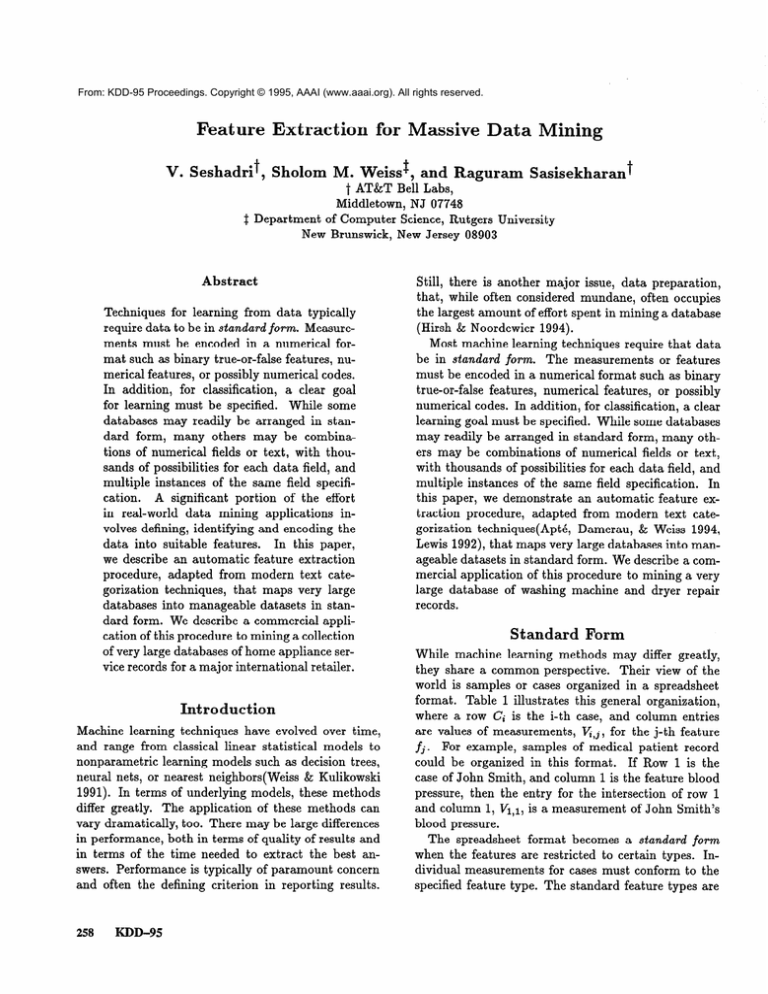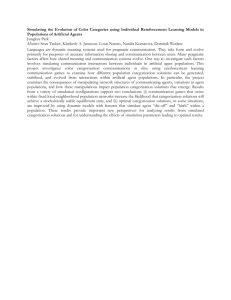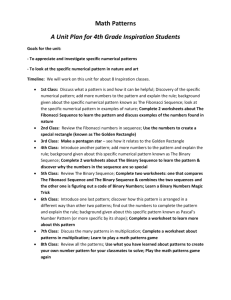
From: KDD-95 Proceedings. Copyright © 1995, AAAI (www.aaai.org). All rights reserved.
Feature
V. Seshadrit
Extraction
, Sholom
for Massive
Data
M. Weiss $ , and Raguram
Mining
Sasisekharan
t
i AT&T Bell Labs,
Middletown, NJ 07748
$ Department of Computer Science, Rutgers University
New Brunswick, New Jersey 08903
Abstract
Techniques for learning from data typically
require data to be in standard form. Measurements must be encoded in a numerical format such as binary true-or-false features, numerical features, or possibly numerical codes.
In addition, for classification, a clear goal
for learning must be specified. While some
databases may readily be arranged in standard form, many others may be combinations of numerical fields or text, with thousands of possibilities for each data field, and
multiple instances of the same field specification. A significant portion of the effort
in real-world data mining applications involves defining, identifying and encoding the
data into suitable features. In this paper,
we describe an automatic feature extraction
procedure, adapted from modern text categorization techniques, that maps very large
databases into manageable datasets in standard form. We describe a commercial application of this procedure to mining a collection
of very large databases of home appliance service records for a major international retailer.
Introduction
Machine learning techniques have evolved over time,
and range from classical linear statistical models to
nonparametric learning models such as decision trees,
neural nets, or nearest neighbors(Weiss & Kulikowski
1991). In terms of underlying models, these methods
differ greatly. The application of these methods can
vary dramatically, too. There may be large differences
in performance, both in terms of quality of results and
in terms of the time needed to extract the best answers. Performance is typically of paramount concern
and often the defining criterion in reporting results.
258
KDD-95
Still, there is another major issue, data preparation,
that, while often considered mundane, often occupies
the largest amount of effort spent in mining a database
(Hirsh & Noordewier 1994).
Most machine learning techniques require that data
be in standard form. The measurements or features
must be encoded in a numerical format such as binary
true-or-false features, numerical features, or possibly
numerical codes. In addition, for classification, a clear
learning goal must be specified. While some databases
may readily be arranged in standard form, many others may be combinations of numerical fields or text,
with thousands of possibilities for each data field, and
multiple instances of the same field specification. In
this paper, we demonstrate an automatic feature extraction procedure, adapted from modern text categorization techniques(Apt6, Damerau, & Weiss 1994,
Lewis 1992), that maps very large databases into manageable datasets in standard form. We describe a commercial application of this procedure to mining a very
large database of washing machine and dryer repair
records.
Standard
Form
While machine learning methods may differ greatly,
they share a common perspective. Their view of the
world is samples or cases organized in a spreadsheet
format. Table 1 illustrates this general organization,
where a row Ci is the i-th case, and column entries
are values of measurements, Vi,j, for the j-th feature
fj. For example, samples of medical patient record
could be organized in this format. If Row 1 is the
case of John Smith, and column 1 is the feature blood
pressure, then the entry for the intersection of row 1
and column 1, VI,~, is a measurement of John Smith’s
blood pressure.
The spreadsheet format becomes a standard form
when the features are restricted to certain types. Individual measurements for cases must conform to the
specified feature type. The standard feature types are
features and measurements is more than a straightforward mechanical process. The transformation represents a general conceptual model that is applicable
across a broad group of learning methods.
Computer-based learning methods can be divided
into roughly 3 categories:
Table 1: Spreadsheet Data Format
weighted methods, such as linear discriminants
neural nets;
and
symbolic methods, such as decision trees or rules;
the following:
0
binary true-or-false variables
0
ordered variables. These are numerical measurements where the order is important and X > Y has
meaning. A variable could be a naturally occurring
measurement such as age, or it could be an artificial
measurement such as a severity index for grading
illness.
Although some techniques can also handle unordered
(categorical) variables or artificial codes, most approaches will translate these into many binary variables. All of the standard form variables are measured
as numerical values.
While databases are sometimes found in spreadsheet
format, or can readily be converted into this format,
they often may not be easily mapped into standard
form. Some of the difficulties that can be encountered
with mapping data into standard form data fields are:
High dimensionality. The number of possibilities for
an unordered feature may be very large. For example, the number of models and replacement parts for
products such as washing machines may number in
the thousands.
Free text. The data field may allow for free text that
cannot be anticipated in advance. For example, in
a washing machine repair context, the complaint of
the customer may be recorded.
Replication of fields. It may be necessary to specify
multiple instances of the same feature. The order
of the features is not meaningful. For example, a
data field might be a part that was replaced. Multiple parts may be necessary in order to successfully
complete a repair. A database may allow for this
type of situation by allocating several data fields for
specification of a part replacement.
These three issues of dimensionality, free text, and
field replication, strongly support the idea of mapping
data into a standard form. However, the mapping into
case-based, i.e nearest neighbor methods.
For ordered numerical variables, all methods can
readily reason with these variables (possibly with minor normalizations). At one time some symbolic approaches, notably decision tree methods, did treat ordered numerical variables like categorical variables.
Most empirical evidence supports the conclusion that
(multiple) binary decisions, using ‘greater than’ and
‘less than‘ operators, is a more effective approach.
The main difficulty is with unordered numerical variables, i.e. codes. Because a specific code is arbitrary,
it is not suitable for many methods. For example, a
weighted method cannot compute appropriate weights
based on a set of arbitrary codes. A case-based method
cannot effectively compute similarity based on arbitrary codes. While some symbolic methods may process codes without the transformation into multiple binary codes, they will implicitly make this transformation, for example binary tree induction. An exception
is non-binary tree induction, a method which can be
mimicked, often more compactly, by binary tree induction. The standard form model presents a data transformation that is uniform and effective across a wide
spectrum of learning methods.
Describing
the Goal
A dataset can be in standard form, but at least one of
the features is given a special designation. Typically,
this is a class label. For classification or prediction, we
must describe the target. The objective then becomes
a mapping from the other variables to the target or
class. Often, the designation of a target requires careful consideration prior to data accumulation. For data
mining, we might expect to be less certain of targets,
and we may be engaged in a wide search to find patterns in the data without having an easily specified set
of goals and classes.
Mapping
Databases
Text Categorization
into
Standard
Form
Before we directly consider the transformation of a
database into standard form, let’s examine a different
Seshadri
259
problem known as text categorization. Text, which can
be any written document, would appear to be very far
from standard form, and possibly the least amenable
form of data for data mining. One might suspect that
an analysis of the written word would introduce more
complicated issues, such as human reading and comprehension.
The task of text categorization is usually performed
by humans. They read documents, and assign a label
or topic from a pre-specified code sheet. This process
categorizes articles by topics of interest, and allows for
effective dissemination and future retrieval. For example, the Reuters news service has hundreds of topics,
like sports or financial stories, to which newswire articles are assigned.
If we consider the divergence of text data from the
standard model, we see that the data is organized by
case, and a label is typically assigned to each case by
the human reader; but the initial feature set specification is missing. Thus, to map the text data into
standard form, two tasks must be achieved: (a) specification of a feature set, and (b) measured values of
these features for each case.
Figure 1 gives an overview of the process of mapping a database of text documents into standard form.
Research results in text categorization demonstrate
that a comprehensive statistical analysis of word frequencies in labeled documents combined with relatively
strong machine learning techniques can lead to effective automated categorization systems(Apt6, Damerau, & Weiss 1994). While there are many variations
on the basic methodology, we considered one basic approach. This approach can be improved somewhat
for text categorization, but our task of data mining
is somewhat different. The most direct approach to
the mapping process was found to be quite effective.
In Figure 1, the first step is the creation of a word
dictionary. This dictionary contains the feature set.
A word is a set of non-numeric characters that are
preceded and succeeded by word boundary characters
(non-alphabetic characters like blank characters). It is
a relatively simple process to find and sort all words
that appear in a text document. Of these words, the
most frequently occurring j words are selected. This set
of j words contains, as might be expected, some words
that are of little predictive value, words such as “the”
or “it.” A separate stopword dictionary is maintained,
containing a list of frequently occurring nondiscriminatory words. These words are then removed from the
main dictionary, and the remaining Ic frequently occurring words are maintained in the dictionary along with
the class label. The dictionary, then, is the set of Ic
features for the text categorization task.
260
KDD-95
After completing the above-mentioned procedure,
the set of measurements for each case is still missing.
In Figure 1, the next step is indicated, namely, mapping of the text for each case into standard form. This
is accomplished by searching for the presence of each
dictionary word in the text for each case. If the word
is found, the value of the measurement is true; otherwise it is false. At the completion of this step, we now
have a standard form data set, one that can be used
by many machine learning methods.
General
Feature
Extraction
Variations of the feature strategy that we have described have proven effective for text categorization.
Large datasets, with high dimensional feature spaces,
are mapped into a standard form that is effective for
machine learning. A very large database may have
more structure than pure text. Clearly, those data
fields that are in standard. form can immediately be
used. Those data fields that are known to be irrelevant
can be eliminated. The issue to be addressed is what
to do with the fields that are not in standard form, particularly those with high dimensions. In this paper, we
describe the use of text categorization techniques with
the following modifications for feature extraction prior
to general data mining:
l
l
A word consists of alphanumeric characters
Every word in the dictionary is a valid candidate for
designation as a class label.
Alphanumeric characters are now allowed because
many coded fields may contain them, for example,
descriptions of parts of a product. Because the objective is data mining and there are no prior designated class labels, experiments are performed to cycle
through all binary features. This process determines
whether any patterns emerge with some predictive capability. While patterns may emerge, domain experts
determine whether these patterns are noteworthy.
Experimental
Results
and Discussion
A large database, with data fields in non-standard
form, was compiled from several databases of maintenance and repair records for an international merchandiser. The initial analysis was limited to a portion of
the records, namely washing machine and dryer records
over several months, with a view to test whether the
above-mentioned approach would yield results of commercial value; if so, the goal was to extend the approach to a broader set of appliances.
The collated database contained 10,000 cases. The
cases were a few months’ records of service calls made
n
Documents
I
IJ
0
Document
Classification
Rules
Figure 1: Overview of Text Categorization
for a well-known brand of washing machines and dryers, and covered a large geographical area across North
America. Figure 2 illustrates the type of data, and the
dimensions of some of the database fields. For example, it is not surprising that in a real-world application
of this sort, there are 1100 different types of parts that
are replaced. For each service call, up to 10 parts are
entered into data fields. If multiple parts are replaced,
there is no preferred order for noting a part in any of
the 10 fields allocated for the description of replaced
parts. Another field contains information about the
initial phone call made by the customer to describe
the problem, and is free form text up to a limit of 100
characters.
As can be seen by perusing the table, these data
are not in standard form. We applied the procedures
described earlier to the data, with an upper limit of 200
features. After eliminating stopwords, approximately
150 features remained. Once in standard form, each
of these binary features was temporarily considered to
be a labeled endpoint. In effect, 150 classification and
prediction experiments were performed. For each label,
an attempt was made to find an associative pattern.
For example, an examination was made to determine
whether there was any pattern in predicting that a
specific part will need to be replaced, or any pattern
associated with a specific model year.
As noted earlier, many different learning methods
can be applied to a dataset in standard form. In our
case, we applied a learning method that induces decision rules(Weiss & Indurkhya 1993), rules in the form
of conjunctions of features. For example: If X AND
Y then conclude Z. For the 150 endpoints that were
examined, over 500 patterns were discovered.
Not all of these induced relationships were novel in
the domain of washing machine products. Many were
well-known to workers in the industry, and only novel
to outsiders. Others were previously unknown to domain experts, but made sense upon reflection and examination. Both types of relationships were useful; the
former type lent credibility to the approach, while the
latter type could be used to improve maintenance and
repair performance.
Domain experts indicated that
each 1 per cent improvement in performance would result in 20 million dollars increase in net revenue.
At the time of writing of this paper, domain experts
were considering the applicability of this approach to
multiple lines of appliances. Even if only one useful relationship is found in a merchandise category, it could
have significant financial impact. From a technical perspective, however, the data are not well-formed, and
the specific goals are ill-defined. In this paper, our
objective has been to show how a difficult technical
problem of feature extraction and high dimensionality
can be made tractable. The procedures that have been
described have proven feasible and efficient in automatically mapping a large database into a productive form
for data mining.
Acknowledgments
Sholom Weiss received research support from NIHNCRR grant RR-6235.
Seshadri
261
Description
Parts
Model
Model Year
Customer complaint
Categories
1100
100
25
3000
Instances
10
1
1
1
Type
alphanumeric code
alphanumeric code
number
free text
Table 2: Examples of Data Fields
References
Apt&, C.; Damerau, F.; and Weiss, S. 1994. Automated Learning of Decison Rules for Text Categorization. ACM Trunsuctions on Ofice Information
Systems 12(3).
Hirsh, H., and Noordewier, M. 1994. Using Background Knowledge to Improve Inductive Learning.
IEEE EXPERT 9(5):3-6.
Lewis, D. 1992. Text Representation for Text Classification. In Jacobs, P., ed., Text-Bused Intelligent
Systems. Lawrence Erlbaum.
Weiss, S., and Indurkhya, N. 1993. Optimized Rule
Induction. IEEE EXPERT 8(6):61-69.
Weiss, S., and Kulikowski, C. 1991. Computer Systems that Learn: Classification and Prediction Methods from Statistics, Neural Nets, Machine Learning,
and Expert Systems. Morgan Kaufmann.
262
JCDD-95



